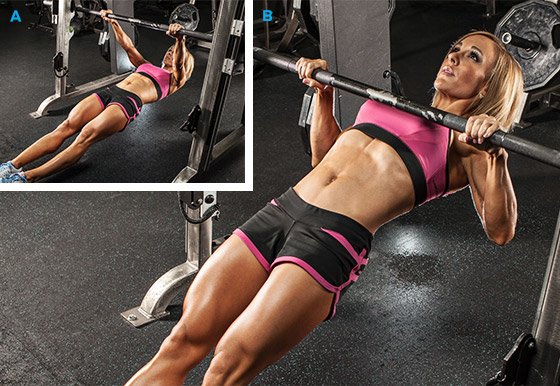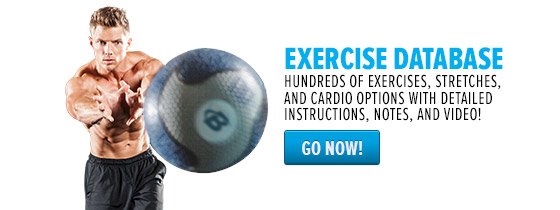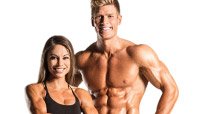A lot of lifters think they can tell how effective their training is simply by looking at themselves from the front—in other words, by checking out their chest, quads, biceps, and abs.
Increasingly, coaches and online fitness smarties are taking the reverse course. They gauge the quality of your training by how you train your back, and how well that matches up to a certain checklist of movements.
So, what does a smart lifter's back regimen supposedly look like? Stop me if you've heard this one before:
These are all solid choices for putting on strength and size, and they are certainly a worthy foundation of your back training, but they're not your only choices.
If you want to stimulate the most possible growth in your back, or if your body type makes the classic pulls less than ideal, consider these four alternatives I can almost guarantee you've never heard of!
Exercise 1 The "J" Rope Pull-in
The "J" rope pull-in combines a stiff-arm pull-down with a modified seated row. The start and finish position allows full lat activation with every rep, making it a great movement to stimulate growth, particularly in the middle back.
"J" Rope Pull-Ins
Watch The Video - 00:15
While kneeling with arms stretched overhead, set your shoulders down. Start the movement like a stiff-arm pull-down with your arms straight, elbows flared, and hands apart. Smoothly transition with an arcing motion into a row movement—the turn makes it a "J" pattern—and finish with hands at the middle of your abs.
Exercise 2 Cobra Pull-down
This unilateral twist on the standard pull-down adds significant range of motion to the move, since the hand starts almost directly over your head. Like the "J" rope pull-in, it'll effectively isolate your lats and send them a serious message to grow.
Cobra Pull-Down
Watch The Video - 00:17
As an added benefit, your elbow is in a stronger position during this movement than during a standard pull-down. This gives you a little more wiggle room to experiment and make personal adjustments to further hit your lats or work around tight pecs.
Exercise 3 Inverted Rows
OK, I lied. Maybe you've heard of this exercise variation before. But, if you're like most people, you dismissed this type of bodyweight work as too low-intensity to properly challenge your muscles to grow. But this isn't the case; just think of chin-ups. Do a few supersets of chin-ups and inverted rows, and tell me you don't feel ready to grow!

Inverted Rows
Inverted rows are performed by setting a bar in the rack or Smith machine at waist level, and then hanging under the bar with your feet on the ground. Maintaining a rigid trunk, pivot around your feet and pull your body up until your chest comes into contact with the bar. Those last couple of inches are the killers.
To make things more difficult, add a weight vest or elevate your feet using a box about as high as the bar. You'll respect the row soon enough.
Exercise 4 Kettlebell Angled Press
I saved the best for last. It's relatively easy to hit the upper traps with classic moves like shrugs, cleans, and high pulls. When it comes to the lower traps, however, activating them isn't nearly as simple, let alone isolating them enough to add thickness.
The kettlebell angled press hits the middle and lower traps like no other exercise I've found. Sliding your hands out over your head at an angle creates a huge lever arm that the traps have to struggle against, but without tiring the shoulders as much as other well-known trap-builders like the trap 3 raise or upright row.
It doesn't take much weight to get a huge amount of stimulation—as you can see in the video, 20 pounds gave me all I wanted—and this can really beef up the section between the shoulder blades.
Kettlebell Angled Press
Watch The Video - 00:32
Start by grabbing a light kettlebell by the sides of the handle using a neutral grip (palms facing each other). Draw the shoulders back and pull the bell close to your chest. Pivot forward to a 45-degree angle by hinging at the hip.
At this point, you should look like you're in the position to do a bent-over row. However, don't look forward, like many people do during barbell rows. Instead, look at the floor throughout the movement. Now "slide" your arms up and down along the angle your body has created—no higher, no lower. You'll really have to fight against gravity!
A couple of tips to get the most out of this movement:
Don't do it too quickly. The angled press is very precise, and it takes concentration to get it right. Speed doesn't benefit you here.
Maintain your angles. It's really easy to begin "standing up" as the set progresses and you become fatigued. Keep the same torso position you started with.
The Truth about Back Exercises
Why is it important to have a full arsenal of training options for your back? Because, as I've written about in the past, not everyone is built to perform movements with the same form.
Tall guys might need to tweak a lift one way to achieve proper range of motion, and guys who carry more mass than the average individual might benefit from a different change. This definitely comes into play with a movement like the lat pull-down, as I show in this video.
The Truth About Back Training
Watch The Video - 05:44
Internet commenters tend to act like there's only one version of a squat or pull, but working coaches and athletes know that ideal technique isn't written in stone. Your build and body type matter, so keep an open mind and stay committed to finding what works for you!

Recommended For You

Beat Butt Wink: Squat Big Without Hurting Your Back
Something strange is happening at the bottom of many lifters' squats. It goes by the name of butt wink, and if it's severe, it puts their back health and lift numbers at risk. Here's what you need to know!
Power Panel: 4 Deadlifting Cues From Pro Coaches!
Strength coaches Tony Gentilcore, Dean Somerset, Lee Boyce, and Todd Bumgardner offer their best deadlifting cues. Rip the barbell from the ground!

